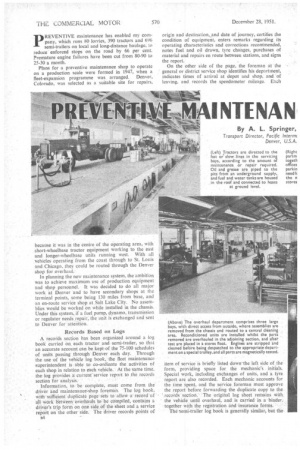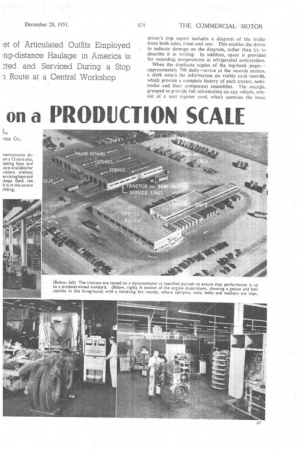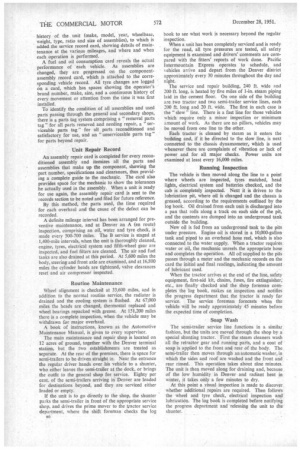Pd INTENAN on a PRODUCTION SCALE By A. L. Springer,
Page 38

Page 39

Page 40

Page 43

If you've noticed an error in this article please click here to report it so we can fix it.
Transport Director, Pacific intermc Denver, U.S.A. pREVENTIVE maintenance has enabled my company, which runs 80 lorries, 390 tractors and 696 semi-trailers on local and long-distance haulage, to reduce enforced stops on the road by 66 per cent. Premature engine failures have been cut from 80-90 to 25-30 a month.
Plans for a preventive maintenance shop to operate on a production scale were formed in 1947, when a fleet-expansion programme was arranged. Denver, Colorado, was selected as a suitable site for repairs, because it was in the centre of the operating area, with short-wheelbase tractor equipment working to the east and longer-wheelbase units running west. With all vehicles operating from the coast through to St. Louis and Chicago, they could be routed through the Denver shop for overhaul.
In planning the new maintenance system, the ambition was to achieve maximum use of production equipment and shop personnel. It was decided to doall major work at Denver and to have secondary shops at the terminal points, some being 130 miles from base, and an en-route service shop. at Salt Lake City. No assemblies would be worked' on while installed in the chassis. Under this system,, if a fuel, pump, dynamo, transmission or regulator needs repair, the unit is exchanged and sent to Denver for attention.
Records Based on Logs A records section has been .organized around a log book carried on, each tractor and semi-trailer, so that an accurate account can be kept of the 75-100 schedules of units passing'through' 'Denver each day. Through the use of the vehicle log book; -the fleet maintenance superintendent is, able to co-ordinate the activities of each shop in relation to each vehicle. At the same time, the: log provides acurrent service report to the records section for analysis;
Information, to be complete, must come from the driver and maintenance-shop foreman. The log book, with sufficient duplicate page sets to alloW a record of' all work between overhauls to be compiled, contains a driver's trip form on one side Of the sheet and a service report on the other side. The driver records points of B4 origin and destination, and date of journey, certifies the condition of equipment, enters remarks regarding its operating characteristics and corrections recommended, notes fuel and oil drawn, tyre changes, purchases of material and repairs en route between stations, and signs the report.
On the other side of the page, the foreman at the general or district service shop identifies his department, indicates times of arrival at depot and shop, and of leaving, and records the speedometer mileage. Each
item of service is briefly listed down-the left side of the form, providing space for the mechanic's initials. Special work, including exchanges of units, and a tyre report are also recorded. Each mechanic accounts for the time spent, and the service foreman must approve the report before forwarding the duplicate copy to the '.records section. The original log sheet remains with the vehicle until overhaul, and is carried in a binder, together with the registration and insurance forms.
The semi-trailer log book is generally similar, but the driver's trip report includes a diagram of the trailer from both sides, front and rear. This enables the driver to indicate damage on the diagram, rather than try to describe it in writing. In addition, space is provided for recording temperatures in refrigerated semi-trailers.
When the duplicate copies of the log-book pages— approximately 700 daily—arrive at the records section, a clerk enters the information on visible card records, which provide a complete history of each tractor, semitrailer and their component assemblies. The reeorsis. grouped to provide full information on any vehicle, consist of a unit register card, which contains the basic history of the unit (make, model, year, wheelbase, weight, type, ratio and size of assemblies), to which is added the service record card, showing details of maintenance at the various mileages, and where and when each operation is performed. A fuel and oil consumption card reveals the actual performance of each vehicle. As assemblies are changed, they are progressed on the componentassembly record card, which is attached to the corresponding vehicle record. All tyre changes are logged on a card, which has spaces showing the operator's brand number, make, size, and a continuous history of every movement or attention from the time it was first installed.
To identify the condition of all assemblies and used parts passing through the general and secondary shops, there is a parts tag system comprising a "removal parts tag" for all parts removed and needing repair, a "serviceable parts tag" for all parts reconditioned and satisfactory for use, and an "unserviceable parts tag" for parts beyond repair.
Unit Repair Record
An assembly repair card is completed for every reconditioned assembly and itemizes all the parts and assemblies that make up the component, showing the part number, specifications and clearances, thus providing a complete guide to the mechanic. The card also provides space for the mechanic to show the tolerances he actually used in the assembly. When a unit is ready for use again, the assembly repair card is sent to the records section to be noted and filed for future reference.
By this method, the parts used, the time required for each overhaul and the cause of the defect can be recorded.
A definite mileage interval has been arranged for preventive maintenance, and at Denver an A (en route) inspection, comprising an oil, water and tyre check, is made every 500-700 miles. The B service is staged at 1,400-mile intervals, when the unit is thoroughly cleaned, engine, tyres, electrical system and fifth-wheel gear are inspected, and fuel filters are cleaned. The air and fuel tanks are also drained at this period. At 5,600 miles the body, steering and front axle are examined, and at 16,800 miles the cylinder heads are tightened, valve clearances reset and air compressor inspected.
Routine Maintenance
Wheel alignment is checkeil at 33,600 miles, and in addition to the normal routine service, the radiator is drained and the cooling system is flushed. At 67,000 miles the heads are changed, thermostat replaced and wheel bearings repacked with grease. At 151,200 miles there is a complete inspection, when the vehicle may be withdrawn for major overhaul.
A book of instructions, known as the Automotive Maintenance Manual, is given to every supervisor.
The main maintenance and repair shop is located on 12 acres of ground, together with the Denver terminal station, but the two establishments are treated as separate. At the rear of the premises, there is space for semi-trailers to be driven straight in. Near the entrance the regular driver hands over his vehicle to a shunter, who either leaves the semi-trailer at the dock, or brings the outfit to the general shop for service. Eighty per cent. of the semi-trailers arriving in Denver are loaded for destinations beyond, and they are serviced either loaded or empty.
If the unit is to go directly to the shop, the shunter parks the semi-trailer in front of the appropriate service shop, and drives the prime mover to the tractor service department, where the shift foreman checks the log B6 book to see what work is necessary beyond the regular inspection.
When a unit has been completely serviced and is ready for the road, all tyre pressures are tested, all safety equipment is examined and drivers' comments are compared with the fitters' reports of work done. Pacific Intermountain Express operates to schedule, and vehicles arrive and depart from the Denver district approximately every 30 minutes throughout the day and night.
The service and repair building, 240 ft. wide and 200 ft. long, is heated by five miles of 1-in steam piping laid in the cement floor. On one side of the building are two tractor and two semi-trailer service lines, each 200 ft. long and 20 ft. wide. The first in each case is the " slow " line. There is a fast line for those vehicles which require only a minor inspection or minimum amount of work. As there are no pillars, vehicles may be moved from one line to the other.
Each tractor is cleaned by steam as it enters the building and, if it be directed to the slow line, is next connected to the chassis dynamometer, which is used whenever there are complaints of vibration or lack of power and for all major checks. Power units are examined at least every 16,000 miles.
Running Inspection
The vehicle is then moved along the line to a point where wheels are inspected, tyres matched, head lights, electrical system and batteries checked, and the cab is completely inspected. Next it is driven to the lubrication pit, where oil is changed and the chassis is greased, according to the requirements outlined by the log book. Oil drained from each unit is discharged into a pan that rolls along a track on each side of the pit, and the contents are dumped into an underground tank outside the building.
New oil is fed from an underground tank to the pits under pressure. Engine oil is stored in a 10,000-gallon tank and piped to an overhead hose reel, which is also connected to the water supply. When a tractor requires water or oil, the mechanic unreels the appropriate hose and completes the operation. All oil supplied to the pits passes through a meter and the mechanic records on the card the initial and final readings, indicating the amount of lubricant used.
When the tractor arrives at the end of the line, safety equipment, first-aid kit, chains, fuses, fire extinguisher, etc., are finally checked and the shop foreman completes the log book, makes an inspection and notifies the progress department that the tractor is ready for service. The service foreman forecasts when the vehicle will be ready approximately 45 minutes before the expected time of completion.
Soap Wash
The semi-trailer service line functions in a similar fashion, but the units are moved through the shop by a special shunting tractor. First the steam cleaners wash all the retractor gear and running parts, and a coat of soap is applied to the front and rear of the body. The semi-trailer then moves through an automatic washer, in which the sides and roof are washed and the front and rear rinsed. This operation takes about nine minutes. The unit is then moved along for draining and, because of the low humidity in Denver and radiant heat in winter, it takes only a few minutes to dry.
At this point a visual inspection is made to discover whether additional repairs are required. Then follows the wheel and tyre check, electrical inspection and lubrication. The log book is completed before notifying the progress department and releasing the unit to the shunter. Small components are held in racks on the serviceshop floor, so that the mechanics do not have to go continually to the stores. Tyres are stored in a similar manner in the wheel-changing area. An area of 20 ft. by 30 ft. is allocated for tyre service. Retreading and vulcanizing are contracted to an outside concern.
The stores department is in the centre of the building between the service and overhaul sections, with hatcheF, for both. The stores keeps a record of all parts received, their condition and specification. This section is responsible for delivering units to the district service stations and maintains a perpetual inventory from which stock orders are placed.
Only three tractors are out of service at any time for major . repairs. The overhaul department comprises three bays, 40 ft. by 20 ft., with direct access from outside, where the assemblies are removed from the chassis and routed to the central cleaning area. New assemblies are then installed and the tractor is moved to the paint shop for repainting and afterwards shifted up to a frame-aligning pit. Here the complete assembly is checked for alignment, front-wheel setting and final inspection before being sent to the service line in preparation for road work.
Preventing Premature Failure
When the parts and assemblies are taken to the central cleaning area, they are completely stripped before cleaning. Engines are also stripped, cleaned and placed on special trolleys. The radiator repair section, comprising an assembly stand, cleaning tank and testing tank, is also located in the cleaning area. After cleaning, parts are sent to the appropriate bench or area for repair, and all are magnetically tested. This system has saved many premature failures.
There is a wide gangway between benches to enable the stores section to distribute and collect repaired parts, which are properly identified. Each bench is devoted to certain assemblies.
After the engine components are cleaned, inspected and distributed to the various benches, the trolley is moved to the stores area and takes on new or reconditioned parts to be used in overhaul. Special tools are provided for inspection and assembly. After the power unit is assembled it is wheeled across to the test shop and is run-in for six hours, the last hour being at full power.
Shop Layout
The fuel pump and injector room adjoins the engine test shop, thus keeping all assembly work at one end of the building, so that it can be co-ordinated by a specialized engine-assembly supervisor. Adjacent to this is the welding area, in which there are special jigs and fixtures for manufacturing or repairing all parts.
The paint shop, with its separate entrance, is at the opposite end of the building to the engine test shop, and is sealed by fire doors. It receives air through special heaters and blowers, coming in at one end of the shop and passing out at the opposite end through a water wash. Adjoining this are the carpentry and sheetmetal shops.
The semi-trailer overhaul section adjoins the tractor heavy repair department, and is planned for two vehicles to be out of service together. They are parked in the shop with air hoses and electrical connections available for easy access.
Between the service and overhaul shops are washing and changing facilities for the employees. These rooms are cleaned between every shift change and after lunch periods. All employees enter through the front door of the main building, whether going to the office or locker
room. The oncoming shift is thus prevented from visiting the outgoing shift before finishing time. The office block, which is at the front of the premises. houses the purchasing, stores, engineering and record, sections and maintenance clerical staff. Every mechanic is responsible for cleaning up his area when the job is completed and each shift must clean up for the oncoming shift. This rule has been strictly enforced, and it has proved worth while, because of the low accident rate and small turnover of employees.
A fairly large fleet and complete standardization of equipment are required to justify shop operation on these lines. Different makes of equipment can be serviced, but the same procedure must be followed in every detail to make the system function efficiently.
There are now 18-20 scheduled overhauls per month, and the mileage between overhaul has been increased from 70,000 in 1948 to 148,000 in 1950. With a fleet mileage of 2m. per month, premature engine failure has been reduced by approximately. 60 per cent. Maintenance costs have been cut by .14 per cent., even taking into account the higher prices of parts and labour.
Measured in terms of man-hours, the average time spent on each vehicle is quarter hour at 500 miles, 21 hours at 1,400 miles, 3 hours at 5,600 miles, 31 hours at 16,800 miles, slightly over 11 man-hours every 67,200 miles, and 163 man-hours every 151,200 miles, which represents a complete vehicle overhaul and all interim maintenance.
By careful planning of schedules and close attention to maintenance it has been proved that the earning capacity of the fleet can be increased by over 80 per cent. In 1948 the prime-mover operation averaged 300 miles per day and this has now been increased to 550 miles per day.












































































